#Moriori
Explore tagged Tumblr posts
Text

POV: you are the moriori people and your entire race being labelled cannibals when you were actually pacifists isn’t even the worst lie the Canterbury Museum spread about you
#nz#aotearoa#moriori#chch#christchurch#like it’s one thing to lie about someone it’s another thing to lie about their continued existence#history#indigenous history#in the most basic sense#‘hey these guys are alive!!!’ — good starting point#bad midpoint
14 notes
·
View notes
Text
Feel like saying this- if you ever see anyone bring up Moriori people out of the blue in a discussion about co governance or colonial reparations; it should be a HUGE red flag. It's a favorite talking point of racists to "prove" that maori deserved to be colonized and aren't indigenous.
Moriori are from the exact same roots as maori people and arrived here the EXACT SAME FUCKING TIME AS THE MIGRATIONS. The moriori genocide myth has been disproven since NINETEEN SEVENTY SIX.
Yes, many moriori were killed and enslaved by some specific maori. This is and was terrible. But this happened DURING pakeha colonisation, not upon maori arrival to nz. And also pakeha (you know, the people this argument is meant to imply were ushering in a better society for all they were colonising) did nothing to help them despite repeated pleas and having promised to do so in earlier agreements.
They were not a pre-maori group that we killed to make way for ourselves. It is important to acknowledge moriori, and i'm not saying any acknowledgement of them at all is dangerous, but the fact that their history has been appropriated to serve the interests of people who hate moriori just as much as they hate maori, and almost definitely would not be able to distinguish the two, is disgusting.
138 notes
·
View notes
Text
Absolutely fantastic find!
8 notes
·
View notes
Text
Possibily the most important discovery in Polynesian archeology:
"A father and son have made the discovery of a lifetime - an ocean-voyaging waka on Rēkohu/Chatham Islands.
The significant archaeological find included 450 pieces, some with unique carvings and braided rope which suggests the waka could be very old.
The specific origin and age remain a mystery, with local iwi and Moriori offering different theories on its history.
Vincent Dix, father of Nikau Dix, said they did know that three bits of timber tested were all from New Zealand trees.
He said they made the finding at the nearby river, accessed through their farm.
"My son and I were just loading the boat up and taking the dogs for a run up the beach, and just after a big rain, and yeah, that's when Nikau my son saw the bits of timber washing down the river." ..."
...continue


There's a film on youtube:
youtube
Also an article in the Smithsonian Magazine:
A Fisherman and His Son Noticed Strange Pieces of Wood on a Beach. They Turned Out to Be Fragments of a Polynesian Canoe | Smithsonian
10 notes
·
View notes
Text
The Moriori are Polynesians who originally arrived on the islands of Rēkohu & Rangihaute from Eastern Polynesia and New Zealand, sometime around 1400 CE. They had no contact with other people for the next 400 years, and so developed their own distinct culture. The Moriori were a hunter-gatherer society, with strong religious beliefs, including being against war and killing.
Their creation story reminds me of that of ancient Egypt - the personification of the sky was separated from the personification of the earth, thus creating a space where humans would live. The sky goddess, named Rangi, is now propped up by ten pillars and gives light to humanity on the earth.
#rangi#moriori#sky goddess#religion#mythology#aotearoa#polynesia#oceania#early modern history#i love seeing overlap in mythology especially over such long geographical distances
2 notes
·
View notes
Text
Motu I ta Horenga - Hokotehi Moriori Trust
💿 Rongo Moriori New Zealand, 2021
2 notes
·
View notes
Text
Wrong. The Mōriorio are not native to Aotearoa.
For the record, the first Moriori ancestors, according to our own traditions, arrived directly from Eastern Polynesia to Rēkohu [Chatham Islands] . Later waka came over from mainland Aotearoa me Te Waipounamu (it’s a three- to five-day sail) about 500 or 600 years ago. Some stayed and settled and intermarried with ngā uri o Rongomaiwhenua, our founding ancestor from whom all Moriori descend today.
Excerpt from: https://e-tangata.co.nz/reflections/moriori-still-setting-the-record-straight/
Read the whole article, and it'll detail how the 1835 invasion and occupation of Rēkohu by Māori has been used for decades by colonisers as a justification for what they did to Māori.
Your statement is not only wrong, but insulting to the Moriori. You're mentioning them, not out of any care for them, but to justify colonial actions.
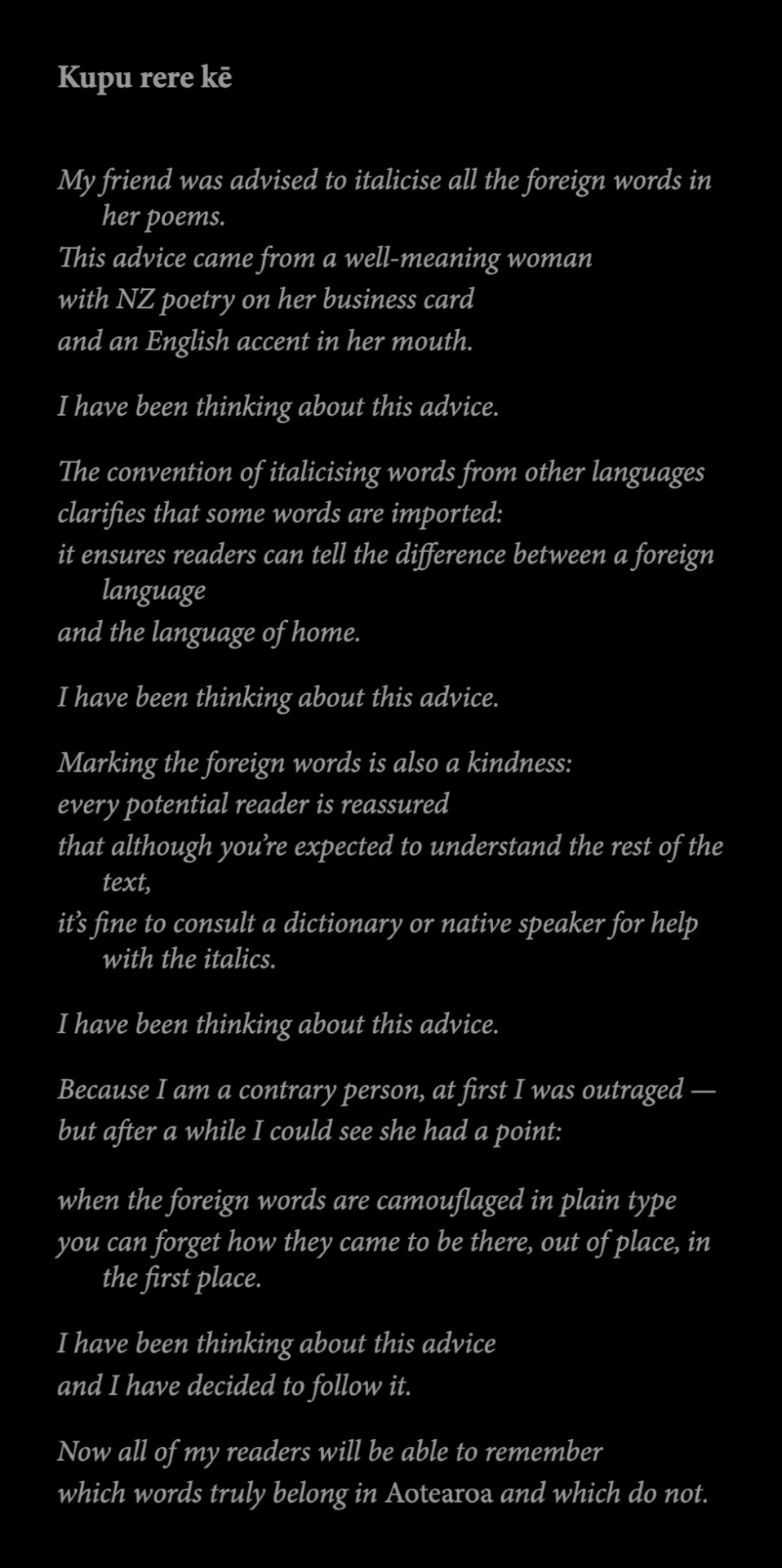
Alice Te Punga Somerville, Always Italicise: How to Write While Colonised - Kupu rere kē
[image ID: Image of the poem “Kupu rere kē” written by acclaimed Maori writer and scholar Alice Te Punga Somerville, Kupu rere kē / My friend was advised to italicise all the foreign words in her poems. / This advice came from a well-meaning woman / with NZ poetry on her business card / and an English accent in her mouth. / I have been thinking about this advice. / The convention of italicising words from other languages / clarifies that some words are imported: / it ensures readers can tell the difference between a foreign language / and the language of home. / I have been thinking about this advice. / Marking the foreign words is also a kindness: / every potential reader is reassured / that although you’re expected to understand the rest of the text, / it’s fine to consult a dictionary or native speaker for help with the italics. / I have been thinking about this advice. / Because I am a contrary person, at first I was outraged — / but after a while I could see she had a point: / when the foreign words are camouflaged in plain type / you can forget how they came to be there, out of place, in the first place. / I have been thinking about this advice / and I have decided to follow it. / Now all of my readers will be able to remember / which words truly belong in Aotearoa and which do not., The poem is all in italics with the exception of the title Kupu rere kē and the word Aotearoa. End ID]

80K notes
·
View notes
Text


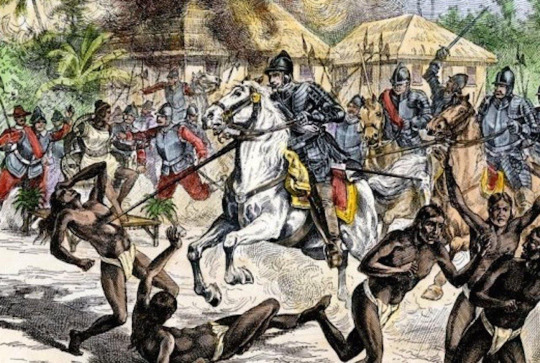

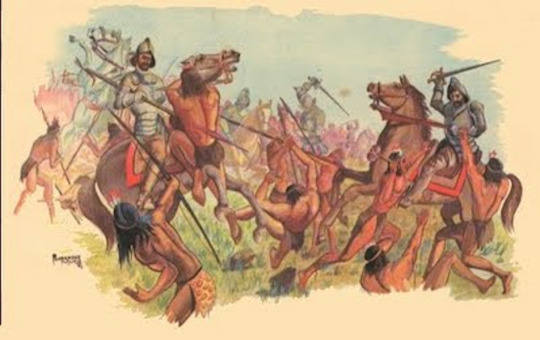




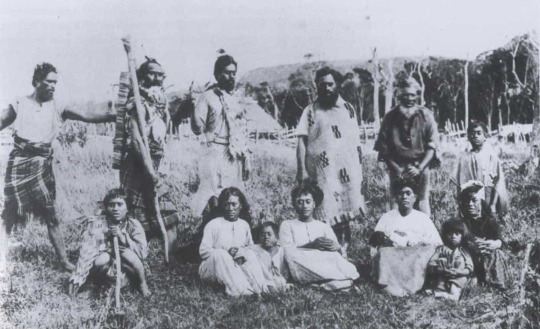


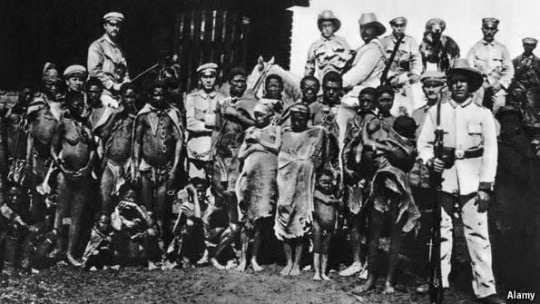


Palestine will be free.
Who Remembers the Armenians?, Najwan Darwish / Myth of the Vanishing Indian, Rena Priest / Shadow Procession, William Kentridge / The Wretched of the Earth, Frantz Fanon / Darfur (Jesus Wept), William F. DeVault / Srebrenica, Safet Zec
#web weave#web weaving#webweaving#palestine#israel#israel palestine conflict#palestinians#gaza#middle east#crusades#armenia#armenian genocide#bosnian genocide#native american#native genocide#the black war#black war#massacre of salsipuedes#moriori genocide#herero and namaqua genocide#herero#namaqua#poetry#poems#colonialism#colonization
347 notes
·
View notes
Text






Day 7 @tolkienofcolourweek: Elwing
Part 25 of toi's indigenous tolkien series
Faceclaim is Moriori and Māori. For Moriori albatross feathers are sacred symbols of peace
[image description
1: white waterfall, text in a circle 'she was born on a night of stars, whose light glittered in the spray of the waterfall of Lanthir Lamath beside her father's house'
2: blue moriori tree symbols, stars, text 'Elwing' and 'Princess of Doriath Lady of Sirion'
3: birds flying, text 'Elwing learned the tongues of birds, who herself had once worn their shape; and they taught her the craft of flight, and her wings were of white and silver-grey.'
4: a young woman with albatross feathers around her, text in a circle 'he gave her the likeness of a great white bird, and upon her breast there shone as a star the Silmaril'
5: lighthouse with bright light, text in a circle ' Therefore there was built for her a white tower northward upon the borders of the Sundering Seas; and thither at times all the sea-birds of the earth repaired'
6: big waves at sea, text 'As a white cloud exceeding swift beneath the moon, as a star over the sea moving in strange course, a pale flame on wings of storm.' and 'shining, rose-stained in the sunset, as she soared in joy to greet the coming of Vingilot to haven.']
#elwing#silmarillion#tolkien women of colour#pacific tolkien#maori tolkien#moodboards and edits#toi's indigenous tolkien series#toi's creations#tocweek2023#rāhiri mākuini edwards-hammond - moriori / ngāti kahungunu o te wairoa / ngā uri taniwha o hine kōrako / ngāti ruapani / rongowhakaata /#taranaki whānui / te arawa
30 notes
·
View notes
Text
If you actually know Māori people IRL then seeing the international community wade into the Discourse this past week feels like watching a toddler step straight into the deep end of the pool
#some of these take havers just googled “moriori” for the first time last weekend and copy pasted the worst results and it shows#anyway it's not a “”“w a r d a n c e”“” it's a genre of oral literature#te rauparaha was a contemporary of coleridge tennyson and byron
1 note
·
View note
Text
Transcript:
TikTok user kokatee (a young Māori woman with a kauae moko tattoo) silently reads a comment from user andpants72 saying "What about Moariori? Where are they?" She silently looks up "hokotehi moriori trust" on her phone and quickly finds their website. kokatee: "There they are. You can even call them on an 0800 number, and you can get their bank account details and you can set up an automatic payment if you care that much about them. But I'm guessing you won't, because this isn't actually about them, is it? It's about you using them to make yourself feel better about being a colonizer."
[end transcript]
90 notes
·
View notes
Text
Since my big Languages and Linguistics MEGA folder post is approaching 200k notes (wow) I am celebrating with some highlights from my collection:
Africa: over 90 languages so far. The Swahili and Amharic resources are pretty decent so far and I'm constantly on the lookout for more languages and more resources.
The Americas: over 100 languages of North America and over 80 languages of Central and South America and the Caribbean. Check out the different varieties for Quechua and my Navajo followers are invited to check out the selection of Navajo books, some of which are apparently rare to come by in print.
Ancient and Medieval Languages: "only" 18 languages so far but I'm pretty pleased with the selection of Latin and Old/Middle English books.
Asia: over 130 languages and I want to highlight the diversity of 16 Arabic dialects covered.
Australia: over 40 languages so far.
Constructed Languages: over a dozen languages, including Hamlet in the original Klingon.
Creoles: two dozen languages and some materials on creole linguistics.
Europe: over 60 languages. I want to highlight the generous donations I have received, including but not limited to Aragonese, Catalan, Occitan and 6 Sámi languages. I also want to highlight the Spanish literature section and a growing collection of World Englishes.
Eurasia: over 25 languages that were classified as Eurasian to avoid discussions whether they belong in Europe or Asia. If you can't find a language in either folder it might be there.
History, Culture, Science etc: Everything not language related but interesting, including a collection of "very short introductions", a growing collection of queer and gender studies books, a lot on horror and monsters, a varied history section (with a hidden compartment of the Aubreyad books ssshhhh), and small collections from everything like ethnobotany to travel guides.
Jewish Languages: 8 languages, a pretty extensive selection of Yiddish textbooks, grammars, dictionaries and literature, as well as several books on Jewish religion, culture and history.
Linguistics: 15 folders and a little bit of everything, including pop linguistics for people who want to get started. You can also find a lot of the books I used during my linguistics degree in several folders, especially the sociolinguistics one.
Literature: I have a collection of classic and modern classic literature, poetry and short stories, with a focus on the over 140 poetry collections from around the world so far.
Polynesia, Micronesia, Melanesia: over 40 languages and I want to highlight the collection for Māori, Cook Islands Māori and Moriori.
Programming Languages: Not often included in these lists but I got some for you (roughly 5)
Sign Languages: over 30 languages and books on sign language histories and Deaf cultures. I want to highlight especially the book on Martha's Vineyard Sign Language and the biography of Laura Redden Searing.
Translation Studies: Everything a translation student needs with a growing audiovisual translation collection
And the best news: the folders are still being updated regularly!
2K notes
·
View notes
Note
from a realistic point of view, i dont see how zionism doesnt lead to non-jewish palestinian death or at least repression. if you have a state which has it enshrined in its founding documentation that it is For "Jewish People" (israel has been carefree about fucking over people they dont consider to be Jewish in the right way). two state solution doesnt even solve it since the assumption is just to have another israel and shove all the people they dont think count as jews over to palestinian state and pretend like they didnt just make an ethnostate
The reason you do not see how it doesn't lead to palestinian death is because on a fundamental level, you do not understand zionism from a jewish perspective.
Jews can and have, taken DNA tests and proved that we are descdant from cannanites who lived in Southern Levant. There is history too proving our orign from the region. A lot of jews were forced out due to various empires wanting to kill us, however some jews remained in the region.
Zionism is simply about self determination for jews as one of the indigenous peoples to the region. It does not inherently imply that palestinians are not indigenous as you can very much have two indigenous groups in a region, eg Moriori and Maori for example, both are indigenous to land which is part of New Zealand, but are two different groups.
I'm not going to say that no zionist ever wants harm to palestinians as there are, however the majority of zionists want a two state solution or a land for all solution (which is different to a one state solution of israel or palestine).
Indigenous groups do deserve self determination. This applies to all indigenous groups world wide. One indigenous group gaining self determination does not inherently harm another group of people, indigenous or not.
Ideologies can be implemented badly and not mean that the inherent concept is bad. For example, communism. No country has ever sucessfully implemented communism as they never leave the transition phase without something going wrong. Saying that zionism always hurts palestinians is like saying that communism is inherently genocidal because of China and Russia.
There are plenty of zionist solutions which does not harm palestinians which are deemed as ideal solutions by zionists, such as versions of a two state solution and land for all solutions.
Israel is also not an ethnostate. The percentage of israeli jews is almost equal to those who are New Zealand European in NZ, yet no one calls NZ an ethnostate. There are plenty of other countries whose majority population is around a similar percentage of 70% - 75% of a country and that country does not get called an ethnostate. Either, all countries with the majority ethnicity percentage above are ethnostates, or the threshold percentage needs to be higher for a country to be an ethno state, or if its only Israel who is an ethnostate and other countries with similar percentage are not, then you hold an antisemitic belief as the only jewish state should not be an exception for purely being a jewish state.
I would also like to touch on yoru usage of "non-jewish palestinian".
Whilst palestinian jews do exist (and I do know one personally), they are a very small minority of palestinians. It is illegal to be jewish in Gaza and the West Bank, so there are no rabbi's there for palestinians to convert. So I am very confused as to what you mean as there are no palestinian jews in palestine, and those that exist in the diaspora are a minority in both aspects, so whilst they deserve recognising and care, your wording is very strange and dogwhistle like. The reason I say dog whistle like, is because it is a common dog whistle for people to say that palestinians are the real jews and who we refer to as jews today are fake jews, which is obviously antisemitic.
99 notes
·
View notes
Text


Rēkohu Carvings
1 note
·
View note
Text
Melian and her Descendants as Native Aotearoa Birds
For day 4 @tolkienofcolourweek
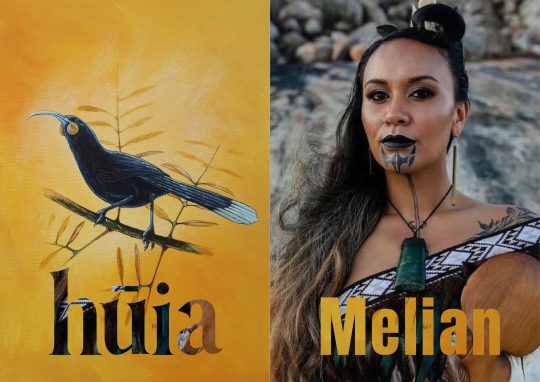
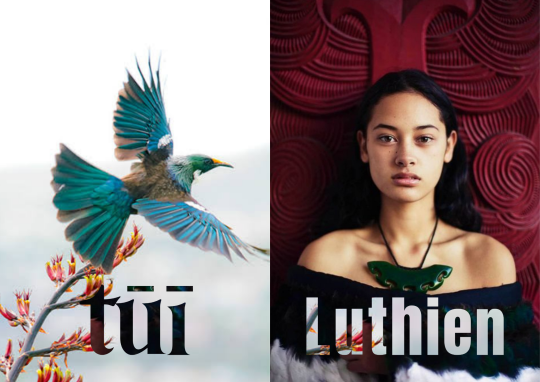
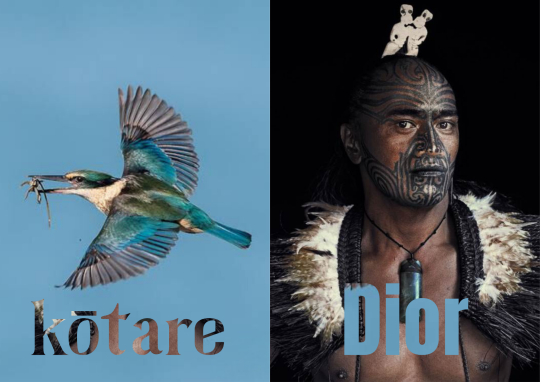
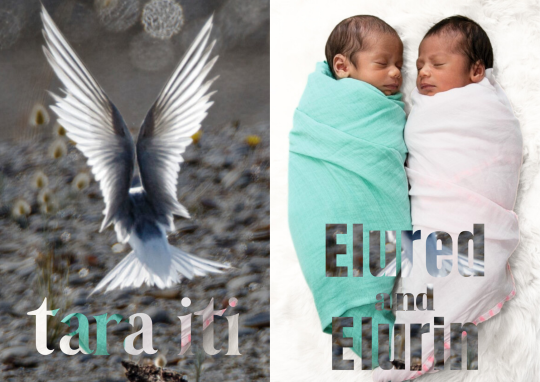

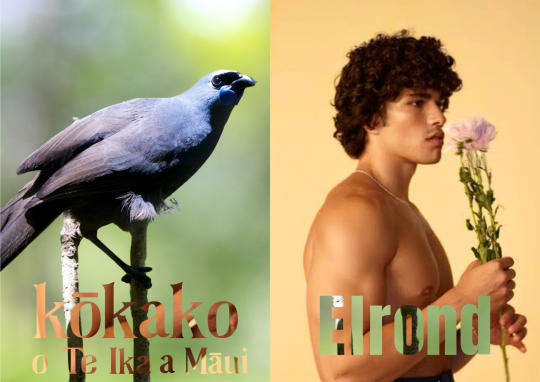


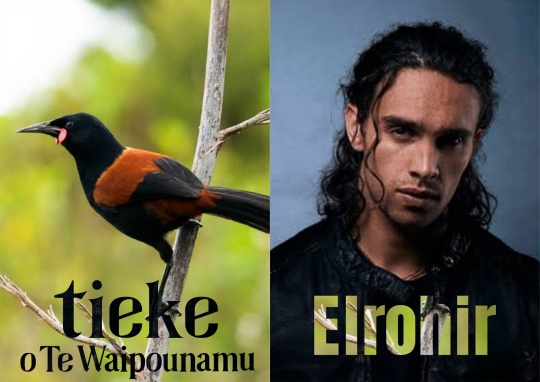

A detailed image description is at the bottom of this post but I've listed the characters and their matching birds below.
Melian: hūia. A sacred bird, often considered to be one of the most beautiful birds in Aotearoa. Their feathers were traditionally only worn by people of high status.
Hūia were forest songbirds who paired for life and were utterly devoted to their partners. The pairs would fly and hunt together, caressing each other with their bills, singing duets back and forth. Often when a hūia died, its partner would die of grief a few days later (typically due to failing to eat or drink).
There was a sharp decline in the numbers of hūia after the arrival of European settlers in the 1840s. By the early 20th century, they had disappeared from our forests forever.
Lúthien: tūī. The most talented of our songbirds, a stunningly beautiful creature with iridescent blue-black feathers. Their double voicebox allows them to mimic almost any sound, including human speech. They often sing all day long.
Tūī are messengers to the gods. In Māori culture we might compliment a singer by saying that they have korokoro tūī, the throat of a tūī.
Also I'm feral about this quote:
Farmer and ornithologist Herbert Guthrie-Smith, writing in the early 20th century, observed of a female tui singing on the nest (tui are the only bird in the world to sing on the nest): “We were close to her, yet she sang as if her song could have no ending, as if the world was too full of the ecstasy of life for wrong and rapine to exist. The sun was shining above the flowing river, the leaves green, of every shape and shade; her great love had cast out fear.”
(Source)
Díor: kōtare, aka the sacred kingfisher. (Yes, okay, this is partially a joke about Dior being a sacred king.) Although kōtare are native to Aotearoa, they're also found in other countries. Most Eastern Polynesian cultures, including many Māori iwi, believe that kōtare have power over the ocean and waves.
Kōtare can sit motionless for hours while waiting for their prey, watching with perfect stillness. For this reason, a person who is alertly watching for enemies is sometimes compared to a kōtare.
Elured and Elurin: tara iti, aka fairy terns.
For Māori, terns in general are associated with people of high status. Tara iti are the smallest species of tern in Aotearoa, weighing in at about 70 grams (or 2.5 ounces). They're also our rarest breeding bird. Sadly, there are only about 40 individuals left.
Elwing: kōtuku - I expanded on this in another post
Elrond and Elros: North Island kōkako and South Island kōkako (respectively). Kōkako are blue-grey songbirds who often have a similar call to tūī, although with a slightly less extensive range of sounds. They love to sing duets; in fact, they sing the longest known duets of any bird in the world.
The North Island and South Island kōkakō are closely related but distinct sub-species. Although the North Island kōkako has been the subject of a successful conservation campaign, the South Island kōkako is considered possibly extinct. (The last two reliable sightings were in 2007 and 1967.) However, some people who walk the remote tracks of the South Island swear they've heard its song.
Elladan and Elrohir: tīeke, aka the North and South Island saddlebacks. The two species are very difficult to tell apart for all but the most trained eyes. They're close relatives of kōkako and hūia.
Tīeke are notoriously fearless. In Māori culture, they're guardians and guides.
Arwen: Chatham Islands tūī. While these birds look extremely alike to mainland tūī, they sing a very different song.
(Since this bird is from the Chatham Islands, the Arwen faceclaim is a Moriori woman. Moriori are the indigenous people of the Chathams.)
Image description below cut due to length.
A series of paired images. Each pair has one bird and one faceclaim. All of the faceclaims, except for Arwen, are Māori.
1: Hūia and Melian. The hūia is a black bird with an orange wattle, long curved beak, and white at the end of its tail feathers. Melian is a dignified woman with light brown skin, brown hair, and a traditional chin tattoo. She wears traditional clothing and a pounamu (greenstone) ornament around her neck.
2: tūī and Luthien. The tūī is in flight. The light has caught its wings and tail feathers, making them look a vivid blue. Luthien is a light-skinned (but distinctly Māori) woman with long dark hair. She wears a black dress and a pounamu necklace.
3: a kōtare and Dior. The kōtare is a blue/black bird with a white neck and underside. It's in flight, carrying something in its mouth. Dior has dark brown skin and facial tattoos that mark him as someone of high rank. He wears a carved bone ornament in his hair, a pounamu necklace, and a traditional feather cloak.
4: tara iti and Elured and Elurin. The tara iti is visible from behind, its white wings spread, either landing or taking off. Elured and Elurin are infants swaddled in blankets side by side.
5: Kōtuku and Elwing. The kōtuku is a gorgeous white bird with a long neck and stilt-like legs. This one standing on a tuft of grass surrounded by water, looking down at its reflection. Elwing is a light-skinned, dark haired pregnant woman wearing a white cloak and cradling her stomach.
6: North Island kōkako (kōkako o Te Ika a Māui) and Elrond. The kōkako is a blue-grey bird with a black beak and blue wattle. The Elromd faceclaim is Alex Aiono (Ngati Porou, Samoa), a man with light brown skin and dark curly hair. In this photo he's shirtless, holding a flower and facing the righthand side of the image.
7: South Island kōkako (kōkako o Te Waipounamu) and Elros. The kōkako looks very similar to the bird above except for its orange wattle. The Elros faceclaim is also Alex Aiono, but in this image he's standing on a beach in front of the sea, smiling.
8: North Island saddleback (tīeke o Te Ika a Māui) and Elladan. The tīeke is a medium sized bird with a red wattle and mixed black/red-orange plumage. My Elladan faceclaim is Jordi Webber (Te Atiawa, Ngāti Toa, Te Arawa, Ngāti Raukawa, Ngāti Maniapoto). He's a young man with pale brown skin, wavy black hair, and grey eyes.
9: South Island saddleback (tīeke o Te Waipounamu) and Elrohir. He is also represented by Jordi Webber.
10: Chatham Islands tūī (tūī o Rēkohu) and Arwen. This tūī is sitting on a flax plant, but it looks very similar to the tūī photo from earlier. It has blue-black plumage, a white tuft at its throat and orange pollen on its head. The Arwen faceclaim is a smiling Moriori woman in front of trees. She has long brown hair, light brown skin and a white dress.]
#melian#luthien#dior#elured#elurin#elwing#elrond#elros#elladan#elrohir#arwen#silmarillion#tocweek2023#māori-fying tolkien#mine#long post#thank u to Toi for showing me how to do the letters thing#i very definitely didn’t overdo it in the slightest
277 notes
·
View notes